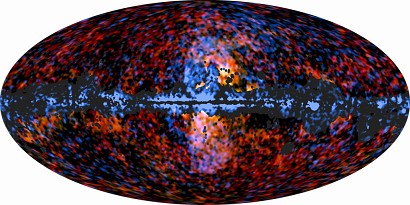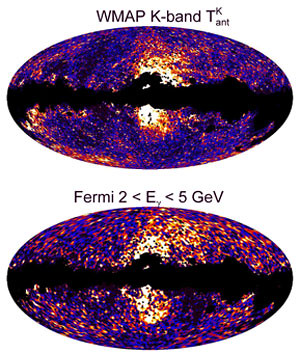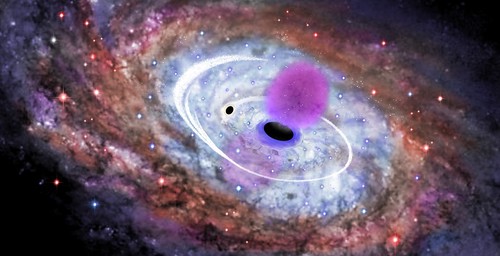Giant Space Bubbles
- By Maggie Masetti
- November 7, 2013
- Comments Off on Giant Space Bubbles
There’s a lot of things we know now about the Milky Way that we didn’t know even a few years ago. When I was in college, for example, there was debate over whether our galaxy was a barred spiral or not. Now we know that our galaxy does indeed have a bar. Which to me is kind of amazing. We live in this galaxy and as such, we will never know what it looks like from the outside. So when we discover something about ourselves that gives us another piece of the bigger picture and takes us another step closer to understanding our corner of the universe, it’s exciting.
Predictably, as much as we do know about our galaxy already, we are still learning things. One of those things is about the nature of giant bubble-shaped structures which stretch tens of thousands of light years above and below the plane of our galaxy. What caused them? We’re still trying to figure it out.

Artist’s conception showing the edge-on Milky Way. The Fermi bubbles are in pink. Credit: NASA/Goddard
A few years ago this giant structure was spotted using data from the gamma ray telescope, Fermi. But how to explain this odd feature – was it even real?

The [top] all sky map doesn’t show the bubbles – but when other gamma ray sources were removed from the data, the dumbbell shaped feature became evident. The bubbles extend 50° north and south from the galactic plane, spanning the sky from Virgo to Grus. Credit: NASA/DOE/Fermi LAT/D. Finkbeiner & others.
Before these huge bubbles were spotted with Fermi in 2010, something called the “WMAP haze” was discovered back in 2004 by Doug Finkbeiner from the Harvard-Smithsonian Center for Astrophysics. Data from the WMAP satellite (which was mapping the faint microwave radiation left over from the Big Bang) showed a sort of haze, or a diffuse excess of microwave radiation, coming from the core of our galaxy. This haze also showed up in more recent microwave data from Planck. [See also this paper.], and in radio data from Parkes Radio Telescope

Haze and bubbles in Planck data. Credit: ESA/Planck Collaboration (microwave); NASA/DOE/Fermi LAT/Dobler et al./Su et al
A 2012 study from Gregory Dobler (Kavli Institute for Theoretical Physics at the University of California, Santa Barbara) found edges in the microwave haze coincident with the edges of the Fermi bubbles.

When known sources of emission were again subtracted, the microwave WMAP data indeed does show a bubble that correlates strongly with the gamma-ray Fermi data. Credit: Gregory Dobler
So it appears the Fermi bubbles are real. They aren’t just an artifact of just one satellite’s data since they are visible at multiple wavelengths of light. And the haze and the Fermi bubbles also appear to be physically related. The microwave photons of light that make up the haze are actually “synchrotron radiation,” something emitted when electrons swiftly corkscrew in a magnetic field. When these same energetic electrons crash into background photons of light, the interaction imparts energy onto the photons, boosting them up into a higher energy of light – gamma rays. These gamma rays were then observed by Fermi.
So to sum up – the same high-energy electrons are responsible for both the microwave and gamma ray radiation that make up the haze and the bubbles. But where did these high-energy electrons come from?
That’s the big question.
There are a bunch of different hypotheses out there, but none seem to have been decided on as the definitive answer. Here are three possibilities.
1) A violent eruption of mighty jets of matter from the black hole at the center of our galaxy. The jet explanation fits in a lot of ways – if jets exploded from the region of the black hole, they would eject high-energy electrons above and below the plane of the galaxy – right where the haze and bubbles were observed. We know that powerful jets originating from a black hole can carve cavities out the dust and gas that surrounds it [link black hole sound story] – the equivalent of blowing bubbles in your milk. In this case though, the bubbles blown were filled with electrons and other particles that were highly energized by the jet. Another effect of a jet is pushing the magnetic field of the galaxy outward, creating a thin magnetic layer around the bubble, essentially giving it a magnetic edge that traps the particles inside. And in fact, these bubbles, created millions of years ago, still have high-energy particles trapped inside, zipping around, and creating high-energy light that was then detected by our observatories.
And though our black hole is quiet today, perhaps it wasn’t quiet millions of years ago.
2) Star formation
Gas outflows from a burst of intense star formation. Could this have formed the bubbles? There are indeed many massive star clusters at the center of our galaxy that were formed several million years ago. So the timing is right.
A recent study looked at the polarization of the radio waves coming from the bubbles, and revealed the kind of magnetic fields associated with rapid star formation. The bubbles also have spiraling ridges, something that could be indicative of star formation, ie, as regions of star formation orbited the galactic center, the output from them spiraled sort of like a lawn sprinkler. Over time, the bubble expanded – and there we have the features seen by Fermi.
How does star formation explain the high-energy electrons? Intense star formation pumps matter, a lot of it, into the surrounding areas – in the form of electrons. Strong magnetic fields also result.
And there is the fact that our black hole is relatively quiet. Maybe there weren’t jets – perhaps that matter was feeding star formation instead.
Read more about this hypothesis.
3) Annihilation of Dark Matter
Dan Hooper (Fermi National Accelerator Laboratory) and Tracy Slatyer (Princeton University) wrote a paper suggesting that the massive outflow of charged particles observed in the Fermi bubbles might be partly due to collisions between dark matter particles that result in their annihilation, emitting charged particles (and gamma rays) in the process.
The problem with the above two theories (jets and star formation) is that neither of these events would produce as many charged particles as are being observed. So perhaps some of the gamma rays observed are due to dark matter collisions.
Read more about this hypothesis.
We look forward to seeing which one of these theories turns out to be right – or perhaps the correct answer will be something entirely different. Every discovery leads to another mystery. We’ve verified the bubbles and haze are real – now we just have to decide why they are there. It reminds me of the days when we didn’t know whether our galaxy was a barred spiral or not. But we figured that one out and I have no doubt we’ll put this puzzle together too. Even so there will be no shortage of future mysteries as we seek to better understand the universe and our place in it.

Artist’s conception, credit Julie Turner (Vanderbilt University).


